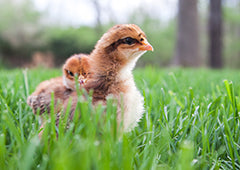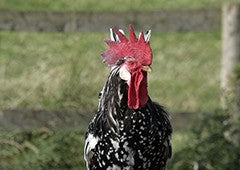Many of us who keep backyard chickens raise them from hatchlings or day old chicks. And, sometimes our curiosity gets the better of us and we wonder whether these fluffy little ones will grow up to be clucky hens or crowing roosters. Perhaps we already have a stately gentleman with fabulous feathers keeping a watch out for our girls, perhaps we are limited by local ordinances to the amount of chicken - men we’re allowed to have in our flock, or perhaps we just don’t wish to have a sunrise alarm sound every morning. So, whether it’s just plain ordinary curiosity or a definite need to know, there are several basic chicken sexing techniques that can help.
The Fabulous Four – Common Methods of Chicken Sexing
As a backyard chicken keeper, you can learn to sex your chicks by simple observation, for the most part. The first and most versatile method for sexing the widest variety of chicken breeds is to note the occurrence of wing feather development. The second method, also involving observation of wingfeathers, differentiates between males and females by inspecting a chick’s wing feather sprout pattern. Thirdly, a chick’s down colour and markings can offer a clue as to gender. Lastly, and the most reliable, as well as, the most complex method of all, is the vent sexing method. Vent sexing involves eggs-amining a chick’s vent cavity or cloaca and looking for a tiny protruding bulb-like sexual organ, which if spotted, signifies that one day that little one will indeed crow!
The first three methods of chicken sexing can easily be performed by humble backyard chicken keepers, noting here that there are always eggs-ceptions! Vent sexing, on the other hand, is a highly complex process which requires years of training due to the fact that there are just so many variables that can cause a misreading. One out of every five chicks does not have an easily recognisable or “typically shaped” sex organ, as well as, the fact that 40% of day old female chicks have similar looking bulb-like protuberances. Thus, breeders and hatcheries employ highly trained persons to perform the chicken sexing process. And, we’re quite thankful that they do, or those of us who live in an area where roosters are prohibited would be faced with the task of finding an appropriate and rooster-friendly new home for our young gent or gents.

Feather Finery- Distinguishing a Chicks Sex by Their Coat
There are two ways to sex a day old chick by observing its feathers. Feather sexing is a simple technique that even an amateur backyard chicken keeper can perform. Yay! First, sexing a chick based on when they develop their wing feathers is easily done through simple observation. Early presence of wing feathers almost always indicates that your baby is a clucky little female. If a male from any Mediterranean chicken breed-Leghorns, Minorcas, Anconas, Andalusians, Spanish, or Buttercups- is bred with a female from any American or Asian breed- Plymouth Rocks, Wyandottes, Javas, Black Jersey Giants, Buckeyes, Chanteclers , Dominiques, Rhode Island Reds, Rhode Island Whites, Lamonas, New Hampshires, Brahmas, Langshans, Cochins- or the English Orpington breed, the female offspring will delightfully hatch with very visible and already well- developed wing feathers! Newly hatched cockerels, on the other hand, greet the world with no visible wing feathers or just a snippet! Time is of the essence when identifying sex though, because within a weeks’ time the fine young gentlemen will have finished their game of catch up and be donning some eggs-quisite wing feathers of their own. It’s still the ladies game though, as they will now have sprouted some wee tail feathers as well! Chop chop, boys!
Let’s take another look at feathers for a moment. The sprout patterns on newly hatched chicks’ wing tips can give us a glimpse into the future. While gently, yet securely holding your chick, spread out their little wing tips. Male chicks will eggs-ibit a neat “all one length” feather sprout pattern, while the females wing tips will show an alternating pattern of long and short feather sprouts. Way to go ladies!

Identifying Gender with “Flying” Colours! Part A
Chicken sexing based on down colour is also an easy and useful method for backyard chicken keepers. Enter sexing by Down Colour! This method is used to sex crossbreeds. Sexing by down colour relies on characteristics passed on from a chick’s parents- roosters pass on their flamboyant feather colour to their sons and hens pass on their pretty plumage colouring to their daughters. Chicks who receive their colouring in this manner are referred to as sex link chickens. Have a peck at our guide to sex link chickens here.
When roosters with golden colouring mate with hens of silvery colouring or pencilled breeds (breeds that eggs-ibit a pattern of pencil-thin ,well-defined stripes on their feathers), gender is reflected in the chick’s down colour-females are buff or reddish, while males are white, creamy or slate coloured. In addition, both sexes may also sport a visible striping.
Golden Coloured Gentlemen: Rhode Island Reds, Brown Leghorns, and the Buff variety of Leghorns, Minorcas, Wyandottes, Plymouth Rocks and Cochins.
Snazzy Silvery or Prettily Pencilled Ladies: White Wyandottes, Columbian Wyandottes, Silver-laced Wyandottes, Columbian Plymouth Rocks, Silver-pencilled Plymouth Rocks, the Light Sussex breed and the Light and Dark Brahmas
A note worthy of mention here is the fact that the males must come from the golden coloured group and the females must come from the silvery or pencilled breeds in order for true sex-link colouring to be eggs-ibited.
Identifying Gender with “Flying” Colours! Part B
The beautiful Barred Rock hen, when bred with any brown headed rooster or rooster from the buff or black variety, delightfully yields cockerels donning white spots on their heads, as well as, yellow beaks, legs and toes. The pullets, however hatch out darker, being all black with dark beaks, legs and toes. The colouring and markings on the above offspring, can also be achieved by breeding Barred Rock hens with white cockerels, such as the white variety of Wyandottes, Langshans, Minorcas, and Dorkings. Isn’t is lovely how nature offers you , the humble backyard chicken keeper, these little clues to help make life easier!
Although this method is usually used when sexing crossbreeds, there are a few standard breeds of chickens that can sometimes be sexed in this manner-the Barred Rock, New Hampshire, and Buff Orpington breeds do present backyard chicken keepers a gift on occasion. All Barred Rock chicks that sport a lovely yellow head spot are males. Now, New Hampshire and Buff Orpington babes that hatch out with a black spot on their wee little heads are females, while newly hatched chicks with a gentle brushstroke of creamy white on their shoulder area are males.
Vent Sexing- A Complex, Yet Very Reliable Method
Vent sexing is the most accurate, but also the most complex method of deciphering the sex of a chicken. As mentioned above, typically, most larger hatcheries and breeders employ egg-sperienced professional chicken sexers due to the complexity of the process, as well as, the fact that prolonged handling of day old chicks by an inexperienced sexer, can be quite stressful on these precious and fragile babies who are only hours old.
To sex a newly hatched baby chick, a professional chicken sexer will gently scoop up the chick and place it in their left hand, its head between their third and fourth fingers. The first order of business is to evacuate or squeeze out any feces that remain in the intestines by pressing ever so gently on the baby’s abdomen. Then, with their left thumb, the sexer rather deftly lifts the left side of the vent up and over while with their right thumb and index finger they pull back the right side of the vent. This allows them to view the cloaca or the area just inside the vent that houses the sexual organs. With eyes focused on the second of three cloacal folds, they search for a tiny shiny protuberance that will poke out from beneath the fold when gentle pressure is applied. If the sexer does in fact spy this very small bulb-like then the chick is identified as a male.
Unfortunately, there are always eggs-eptions and in this case there are far too many which is why this method of chick sexing is so highly complex. One out of every five day old male chicks will not have a typically shaped sex organ-their little bulb-like protuberance may be smaller, may appear flat, may point downward instead of the usual upwards, or may even have uncharacteristic depressions. And to further complicate this process, forty percent of day old female chicks have sexual organs that look similar to a cockerel’s organs. This occurs due to the fact that during the first week of incubation, both male and female embryos eggs-ibit a protuberance. Typically though, these will decrease in size by the second week of incubation, disappearing altogether by the time hatching occurs. Oh but still another caveat enters the mix-in two out of every five pullets, the protuberance does not shrink or shrinks so little that the female chick appears to be a male. Eggs-traordinary fact!
So, if time is of the essence and you need to know the gender of your chicks in order to conform to regional ordinances, these common methods of sexing day old chicks should aid you in your backyard chicken keeping egg-sperience. However, if you’re just of the curious nature and nature doesn’t cooperate leaving you a bit puzzled as to the gender of your wee flock, no worries, time is your friend!
Have you had success with using any of these methods? Tell us in the comments below? Or, if you have a chicken who’s sex you are curious about, post it below and I will help you out!
We all know just how quickly little ones grow up and baby chicks are certainly no egg-ception! So, if you've got some little feathered friends that you're raising, make sure that you've got the knowledge you need to raise a happy, healthy flock. Did you know 67% of chicken keepers surveyed experienced a chicken health or behaviour issues in the first 12 months that they didn’t know how to handle?
But don’t worry! Our feathered friends over at Chickenpedia have created a set of comprehensive online courses with everything you need to know, including food, water and temperature requirements as the little ones grow so you can avoid disasters.
Oh and… as a Chickenpedia member, you will also get access to the Ultimate Chicken Health Course which I highly recommend to all of my readers! It has everything you didn’t know you needed to know (and lots of free guides). So, don’t wing it. Click here to check out Chickenpedia today!


















